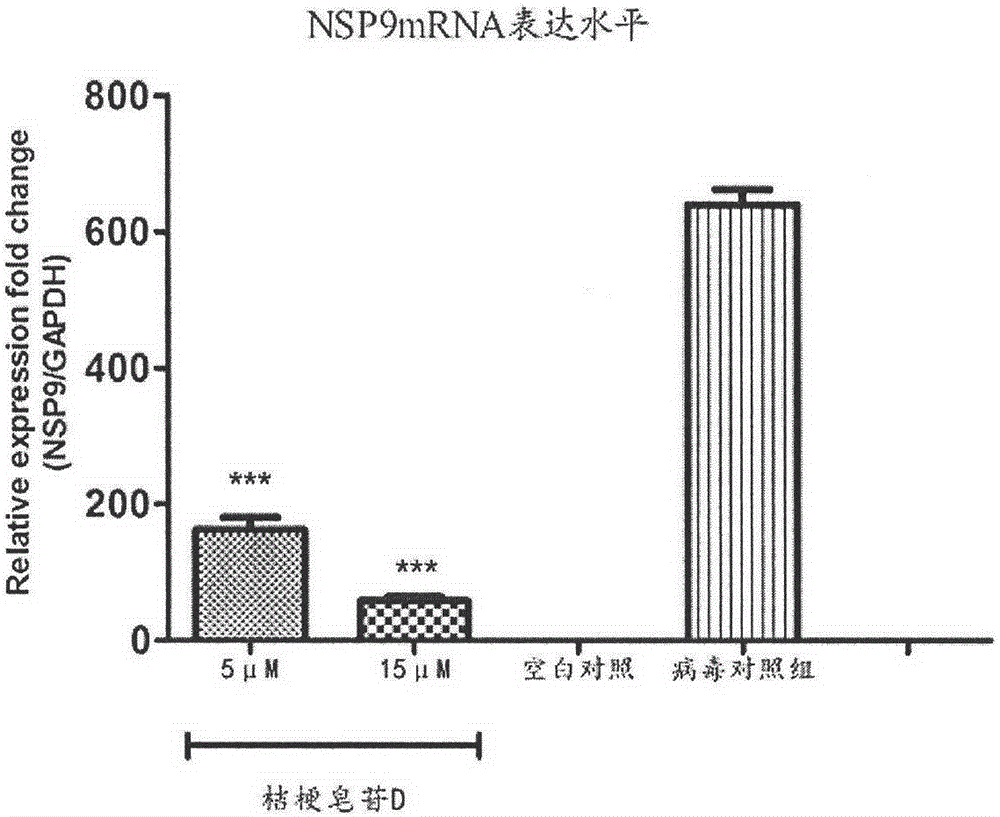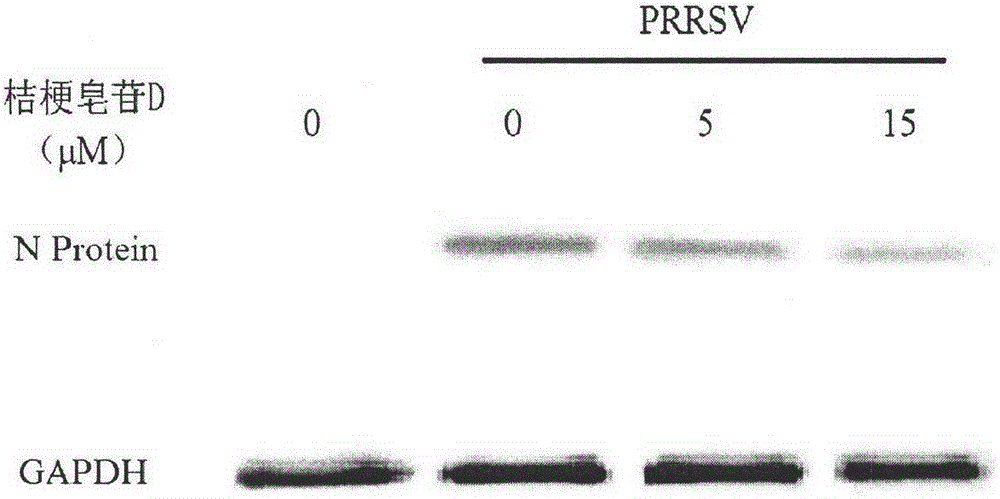Application of platycodin D to preparation of medicine for preventing and treating porcine reproductive and respiratory syndrome
A technology for respiratory syndrome and platycodon saponin, which is applied in drug combinations, respiratory diseases, and pharmaceutical formulations. It can solve problems that have not been disclosed, and its effects have not been reported, and achieve good anti-PRRSV activity.
- Summary
- Abstract
- Description
- Claims
- Application Information
AI Technical Summary
Problems solved by technology
Method used
Image
Examples
Embodiment 1
[0030] Embodiment 1: the protective effect of the medicine of the present invention to the Marc-145 cell that infects PRRSV
[0031] Collect Marc-145 cells in the logarithmic growth phase, and add 0.1 mL (about 3×10 4cells / well), discard the culture medium after the cell monolayer grows to 80% confluence, wash twice with PBS, then add 0.2MOI (multiplicity of virus infection) of PRRSV virus, 100 μL / well, 37°C Incubate for 2 hours, discard the virus supernatant, wash twice with PBS, add 5 μM and 15 μM platycodon saponin D, 100 μL / well, respectively. A normal control group (no test drug, no PRRSV) and a virus control group (no test drug) were set up in the experiment at the same time, and three parallels were set for each test concentration. The cells continued to be cultured for 48 hours, and then the culture was terminated. Discard the supernatant, wash with PBS 3 times, add 500 μl of paraformaldehyde with a mass concentration of 4% to each well for fixation for 10 min; wash ...
Embodiment 2
[0032] Implementation 2: The inhibitory effect of the medicine of the present invention on the proliferation of PRRSV on Marc-145 cells at the mRNA level
[0033] Marc-145 cells in logarithmic growth phase were collected, and 2.0 mL (1×106 cells / well) was added to each well of a six-well plate. After the cell monolayer grew to 80% confluence, the medium was discarded, and PBS was washed twice. Then add 0.2MOI of PRRSV virus, 700μL / well, incubate at 37°C for 2h, discard the virus supernatant, wash twice with PBS, add 5μM and 15μM Platycodon saponin D, 2mL / well, respectively, recorded as PD5μM group and PD15μM group. A normal control group (no test drug, no PRRSV) and a virus control group (no test drug) were set up in the experiment at the same time, and three parallels were set for each test concentration. The cells continued to be cultured at 37°C, and the culture was terminated 48 hours after infection. After observing the lesions, the cell plate was repeatedly frozen and ...
Embodiment 3
[0041] Embodiment 3: The medicine of the present invention inhibits the synthesis of N protein of PRRSV
[0042] Experimental grouping, cell inoculation, virus infection and dosing were the same as in Example 2. Cells were cultured at 37°C until 48 hours after infection, and the culture was terminated. Sample protein extraction and Western blot analysis of N protein were carried out.
[0043] Sample protein extraction:
[0044] Discard the medium after the cells have been cultured for 48 hours, wash twice with pre-cooled PBS, discard the PBS solution, add an appropriate amount of cell lysate according to the number of cells, and keep in an ice bath for 5-10 minutes. The lysate, after the lysis is completed, transfer the liquid to a new EP tube, centrifuge at 4°C (14000rpm, 5min); absorb the supernatant and transfer it to a pre-cooled centrifuge tube, which is the extracted total cell protein. The extracted total cell protein aliquots were stored at -80°C until used for Wester...
PUM
 Login to View More
Login to View More Abstract
Description
Claims
Application Information
 Login to View More
Login to View More - R&D
- Intellectual Property
- Life Sciences
- Materials
- Tech Scout
- Unparalleled Data Quality
- Higher Quality Content
- 60% Fewer Hallucinations
Browse by: Latest US Patents, China's latest patents, Technical Efficacy Thesaurus, Application Domain, Technology Topic, Popular Technical Reports.
© 2025 PatSnap. All rights reserved.Legal|Privacy policy|Modern Slavery Act Transparency Statement|Sitemap|About US| Contact US: help@patsnap.com



